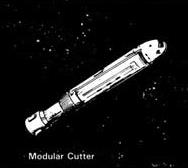Modular Cutter Module
Modular Cutter Modules are a special kind of 30.0 ton cargo container especially built for the standard modular cutter that is ubiquitous throughout Charted Space.
- It is a kind of Cargo Container and Ship Equipment.
Description (Specifications)
They are special detachable modules made especially for standard layout modular cutters and have become so popular that many tramp vessels, cargo liners, freighters, and transports use them as well. The modules exist for every possible purpose.
Image Repository
No information yet available.
Basic Three Cutter Modules
Three modules are routinely available for the cutter:
- The ATV Module, which includes either a wheeled or a tracked ATV, masses thirty tons. It can deposit an ATV on a world surface, as well as pick it up again later. The module can serve as an ATV storage location, if desired. It typically costs MCr1.8.
- The Fuel Module, with 30 tons of fuel tankage, serves as a fuel skimming vehicle and can be used to ferry fuel from point to point. It costs MCr1.
- The Open Module is a customizable frame with 30 tons of excess space which can be allocated to passenger couches, fuel, cargo, cabins, or staterooms. It typically costs MCr2. [1]
Other Kinds of Cutter Modules
Standard Cutter Modules:
- Class I (E) Starport Module: This single module can be left planetside to find the core of a Class E Starport.
- Expandable Base Station Module: This module can form a ground facility for a variety of purposes from civilian administration to paramilitary to military uses.
- Laboratory Module: The is a science module for conducting field research, usually of a planetological purpose.
- Medical Module: This is a portable clinic for conducting medical missions.
- Prison Transport Module: This module includes low berths for transporting dangerous criminals.
- Safari Module: This module includes holding tanks for game, a lounge, equipment storage, and staterooms.
- Survey Module: This module includes a variety of sensor equipment including probes.
Military Assault Cutter Modules:
- Boarding Module: This module includes grappling arms, fusion cutters, and marines for boarding enemy ships.
- ECM Module: This module includes an extensive Electronic Warfare Suite.
- Fighter Pod Module: This module contains a single light fighter, supplies, control equipment, and all other equipment needed to conduct fighter operations.
- Marine Command Module: This module can coordinate marines operations across a planetary warfare campaign.
- Marine Firebase Module: This module can control a variety of deployed fire support equipment including a module-mounted ship turret.
- Medevac Module: This module is designed to conduct medical transport and light treatment of wounded personnel including autodocs.
- Sensor Module: This module contains a powerful militarized Ship Sensor Suite, much more powerful than the suites carried by most smallcraft. This makes it suitable for short-term picket ship duties, light patrol duties, and such.
History & Background (Dossier)
The Cutter was one of the first smallcraft to be purposefully built with modular components. This makes them easily repairable with spare parts and components widely available. It is purposefully built to accommodate parts of higher or lower technologies. It has become one of the eight most popular and commonly encountered smallcraft designs found within Charted Space. [2]
The Modular Cutter is known more simply as the Cutter in many records. Before the First Civil War, most cutters lacked most of the modular features now inherent to the modular cutter. Naval Architects on the Imperial Fringe had begun create innovations on the basic design, which later resulted in today's Modular Cutter. By 622 IC, the new "modular" cutter designs had spread throughout Imperial Space. [3]
Some believe that Ling-Standard Products originated the designs although there isn't a consensus to this assertion. Regardless, LSP Modular Cutter designs remain popular on the smallcraft market. [4]
References & Contributors (Sources)
- Marc Miller. Starships (Game Designers Workshop, 1977), 18.
- Loren Wiseman. "LSP Modular Cutter." Journal of the Travellers' Aid Society 05 (1980): 6-9.
- Marc Miller. Imperial Encyclopedia (Game Designers Workshop, 1987), 81.
- Rob Caswell, William W. Connors, Joe Fugate, Gary L. Thomas. Starship Operator's Manual (Digest Group Publications, 1988), 58.
- Dave Nilsen. Reformation Coalition Equipment Guide (Game Designers Workshop, 1994), 142-145.
- Frank Chadwick, Dave Nilsen. "Technical Booklet." Brilliant Lances (1994): 47.
- Don Perrin. Starships (Imperium Games, 1996), 18-19.
- Loren Wiseman. Deck Plan 2: Modular Cutter (Steve Jackson Games, 2001), 1.
- Loren Wiseman. Deck Plan 4: Assault Cutter (Steve Jackson Games, 2001), 1.
- Loren Wiseman, Andy Akins. Modular Cutter (Steve Jackson Games, 2001), 1-128.
- SGS: Imperial Small Craft
- SGS: Imperial Small Craft Vol. 2
- Martin Dougherty. Scout Ships (Avenger Enterprises, 2007), TBD.
- Traveller Wiki Editorial Team
- Author & Contributor: Lord (Marquis) and Master of Sophontology Maksim-Smelchak of the Ministry of Science
- ↑ Marc Miller. Starships (Game Designers Workshop, 1977), 18.
- ↑ Information provided to the library by Maksim-Smelchak
- ↑ Information provided to the library by Maksim-Smelchak
- ↑ Information provided to the library by Maksim-Smelchak
